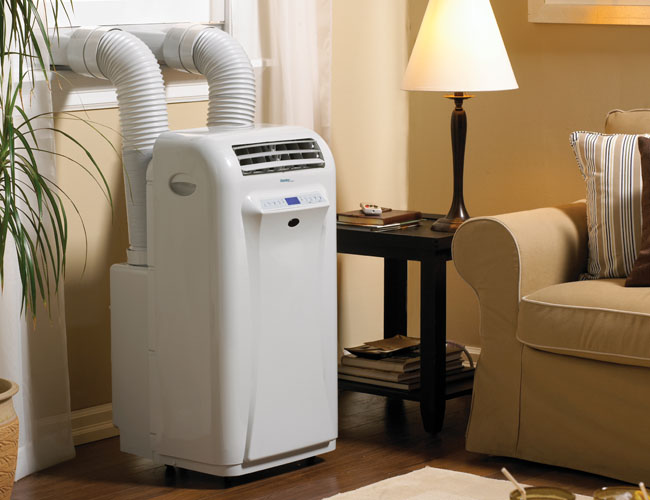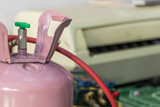Warnings About Portable Air Conditioners

Here are some warnings about portable air conditioners to help you to be aware of their low energy efficiency rating when purchasing a new air conditioner. If you already have a portable air conditioner or if a portable air conditioners are your only option to get some cooling, these fair warnings may help you understand your air conditioner and make better use of it. We will look in details why portable air conditioners are taking more room, wasting more power, producing more noise, and costing more money.
Warning about the term "Portable"
An major claim of portable air conditioners is that they do not need installation and they are portable. On the internet or in the showrooms, we see portable air conditioners neatly displayed without a hose most of the time. In reality all air conditioners need to pass heat to the outside. Central air conditioners and window air conditioners use Freon to carry the heat to the outdoor coils. Fans are used to drive air to cool the outdoor coils.
A portable A/C brings the outdoor coil inside the room but still need to cool the coil. The coil passes the heat to air then the hot air has to be sent out the house. Tip: The longer the total hosing the more power will be wasted to drive air through the hose.
Portable air conditioners need venting kits installed almost the same way as window air conditioners. It is true that the venting kit is much smaller than a window unit. However, you may run into the same installation problems as installing window air conditioners. Do you like the installations in the pictures? Think what the installation will look like in your house when deciding the purchase.
Once installed, “Portable” is questionable. To move the portable A/C to different rooms, we need the venting kit installed in every room or re-install the venting kit for every move. Small wheels may not move well on carpets. Will the move be practical for you? Will the move be easier than with a window air conditioner? Tip: A window air conditioner is more efficient and weigh less as you see below.
Warning on Lower Energy Efficiency
The cooling capacity of an A/C is defined by its BTU/h rating. The BTU/h number indicates the amount of heat the air conditioner can remove from a room each hour. A hot climate will need more heat to be removed from a room to feel cool. A cooler room will also need more heat to be removed for the deeper cooling.
While portable A/Cs might be convenient, those we tested delivered only about half of their cooling capacity—that means they operated with an energy-efficiency ratio (EER) of about 5 or 6. Compare that with the minimum EER of just under 10 for the window air conditioners we’ve recently test (we tested window models with an EER as high as 12).
Central air units and window units have most of this power consumed outside the window and the waste heat is dissipated to the outside air. A portable A/C has all the power consumed inside the house. All consumed power turns to about 30% more heat that has to be removed from the room. This percentage will go higher for a lower EER unit or for a portable air conditioner whose EER has dropped because blocked air flow or dust on the coils.
Warning on exhausting cool air out of the room
Another hidden problem is inherent with single hose portable air conditioners. They suck air from the room and dump it outside. Besides cooling, a single hose portable A/C creates a vacuum for the room it is in. The vacuum may not be measurable if the room is not air-tight. The more air-tight the room is the higher the vacuum will be.
The vacuum enable air from elsewhere to leak into the room for the same amount as the exhausted air, as shown in this picture. If the air is leaked in from outside, it will be humid and hot. If the air is from other rooms of the house, outside hot air will leak into those rooms. So, we may get some cooling near the portable A/C but more heat and humidity will come to the house, as seen in this image.
The tricky thing is that it may take an hour or two to vacuum out the cool air from the surrounding rooms. In the first couple hours, we may feel pretty good about the A/C. We may never thought the other rooms are getting hotter because the use of a single hose air conditioner. That is why we put the word “Warnings” in the title of this article.
To be fair, due hose portable air conditioners do not have this problem. The trade-off is another hose. These hoses will be vibrating in use and could break easily. Any leak in these hoses or their connections will result in dumping room air outside in the same manner as a single hose portable A/C.
The more leaks, heat leaks or air leaks, to the room the more heat need to be removed from the room. Hence, the higher BTU rating is needed. To achieve the same amount of cooling, a single hose portable air conditioner needs a substantially higher BTU rating. The higher the BTU rating, the more power an air conditioner will consume. All the consumed power will turn into heat. That heat also needs to be exhausted through the hose for a portable air conditioner. More heat needs a bigger fan to drive more air out the hose. A bigger fan turns more power to waste heat inside the house.
Conclusion
BTU rating is the amount of heat an air conditioner can remove from a room. For a duel hose portable A/C, about 30% of that heat is the waste heat produced by the unit itself. For single hose portable air conditioner, about 50% of that heat is produced by the unit or sucked in by the unit from outside the house. In comparison, a window unit or a central air unit only has waste heat from the indoor fan for removal that could be less than 5%.
Portable a/c units are a solution for some but, you can't beat a central AC unit. To see a full line of amazing units (and free shipping) go to www.BudgetAirSupply.com.
This may sound confusing to some but, it doesn’t need to be. Just call one of our specialists at Budget Air Supply (855-473-6484) and we can help you determine the best system for your needs and wallet!
Recent Posts
-
Can I Recharge the R410 Refrigerant in My HVAC System?
Keeping your home cool and comfortable during the hot summer months relies heavily on your HVAC syst …14th Apr 2024 -
A Comprehensive Guide to Understanding Straight Cool AC Condensers
Straight-cool AC condensers are vital in ensuring optimal indoor comfort, especially in regions with …7th Apr 2024 -
This 2.5 ton Goodman Package Unit Provides Year-Round Comfort in Mid-Sized Homes.
The Goodman GPGM33006041 Gas Heat/Air Conditioner Package Unit offers an efficient and space-saving …31st Mar 2024



